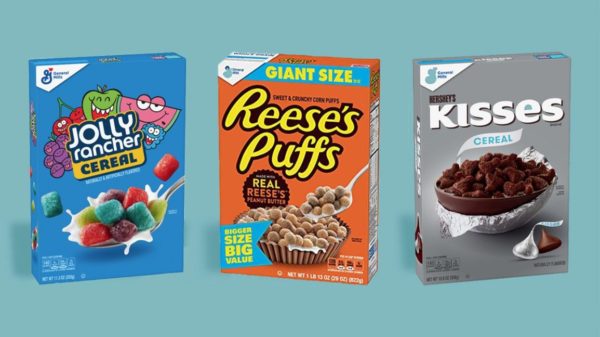
 Share on Pinterest
Share on Pinterest- Three new “candy cereals” are on the market under a new collaboration between General Mills and The Hershey Company.
- A 1-cup serving of the cereals contains 10 to 12 grams of sugar, nearly half the recommended daily amount for children.
- Nutritionists say the morning sugar rush can disrupt a child’s diet for the remainder of the day.
- Over the long term, experts say consuming a high amount of sugar can lead to diseases like obesity and type 2 diabetes.
Don’t be surprised if your children start asking for candy for breakfast.
A new collaboration between The Hershey Company and General Mills means three “candy-coated” cereals are joining the ranks of breakfast foods that are low in complex carbohydrates and high in sugar.
Jolly Rancher, Hershey’s Kisses, and Reese’s Puffs Big Puffs are created from corn, rice, and various added vitamins, colors, and sugars.
Each 1-cup serving amounts to 10 to 12 grams of sugar.
According to the American Heart Association, that’s nearly half the daily recommended amount for children between the ages of 2 and 18 years.
Experts say more important than the amount of sugar is its impact on children’s eating habits, behavior, and long-term health.
“Added sugars should provide less than 10 percent of our daily calorie needs,” said Caroline West Passerrello, MS, RDN, LDN, CLT, a spokesperson for the Academy of Nutrition and Dietetics.
“Why? Because the more calories that come from sugar, and little nutritional value, means the less calories that come from foods with nutritional value,” she told Healthline.
Giving children high sugar foods in the morning has a ripple effect on the rest of the day.
“Experts recommend consuming a balanced meal so that food from the meal is digested and available for energy consistently between meals,” Passerrello said.
“When sugar comes in early in the morning, a time when protein and fiber have been found to be ideal, it can cause rapid blood sugar swings that translate to hunger soon after the meal is eaten,” said Kristin Kirkpatrick, MS, RDN, author of “Skinny Liver.”
“It may make it then more difficult to focus on fruits — which will seem less sweet than sugary cereal and thus not as attractive — vegetables, whole grains, and lean proteins,” Kirkpatrick told Healthline.
In this way, she says, eating sugary foods can have a cyclical impact.
“You eat sugar. You crave more. Then, you continue to feed the craving,” Kirkpatrick said.
The American Academy of Family Physicians lists the main sources of added sugar as:
- candy
- cakes
- cookies
- pies and cobblers
- sweet rolls, pastries, and doughnuts
- dairy desserts, such as ice cream and yogurt
- sugar-sweetened drinks, such as soft drinks, sports drinks, energy drinks, and juice drinks
Passerrello tells parents that every child’s response to sugar will differ.
She says it depends on factors that include their overall diet that day and the total serving size.
At events like birthday parties, children are more likely to exceed their daily sugar intake.
However, birthday parties and everyday breakfast are far from the same.
“In a given day, a high sugar cereal could cause spikes in energy levels, which can have an impact on concentration, academics, and behavior,” Passerrello said.
Kirkpatrick agrees.
“Sugar replaces more vital nutrients needed for growing bodies and provides calories but nothing more in terms of nutritional benefit,” she said.
Over time, excessive sugar consumption can lead to serious health concerns.
“Associations between added sugars and increased cardiovascular disease risk factors among U.S. children are present at levels far below current consumption levels,” the American Heart Association states on their website.
Other associated conditions, according to the American Academy of Family Physicians, include:
- obesity
- type 2 diabetes
- high triglyceride levels
- increased LDL (bad) cholesterol levels
- decreased HDL (good) cholesterol levels
Experts say parents should read cereal labels and look for varieties that are lower in added sugars and higher in fiber and whole grains.
Passerrello’s technique focuses on modeling healthy behaviors and teaching children the difference between certain food choices.
“I recommend that parents model the healthy behaviors they want their children to form: balanced meals and balanced days,” she said.
“Balanced meals, meaning a focus on meals that provide a variety of nutrients from whole foods. Balanced days, meaning there is room for some (no more than 10 percent of calories) added sugars,” Passerrello explained.
Modeling behavior includes consistency and repetition, she says. Results will come with time.
“We talk about ‘go-slow-whoa’ foods in our house and when I do early childhood nutrition education. This doesn’t mean any one food is good or bad, but rather there are foods to have every day and foods to have every once in a while,” Passerrello said.
“Just choose mindfully, limit the portions, and think about the balance of nutrients throughout the day,” she said.